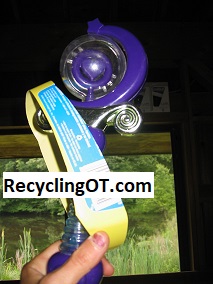
I have found that materials that vibrate often motivate babies, older children and adults with disabilities to grasp and manipulate objects. The toy industry understands the lure of vibration-so has produced teething rings that vibrate when munched on and toys such as motorized balls and electronic ring stacks that flash and vibrate after the last ring is added. The picture above shows a ring stack made with a Princess Wand I activate to vibrate, make sounds and flash after the ring is placed.
People of all ages and abilities may utilize vibrating devices such as
- Self care products such motorized toothbrushes, cushions and back massagers
- sexual aids ( I won't say more....)
- Bassinets, cribs, lounge chairs and other positioning equipment
- Alarms and ringers for hearing impaired people and
- of course, toys and tools such as a motorized pen or Princess Wand.
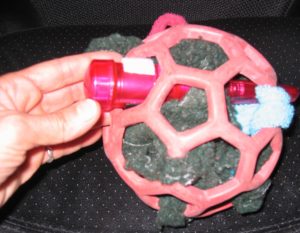
Vibration provides tactile (or touch) sensory stimulation to skin and proprioceptive stimulation to muscles, joints and ligaments. This proprioceptive stimulation promotes body awareness so that we know where our body parts are in space and how they are moving in relation to each other. Many children and adults of all ages enjoy materials adapted to vibrate including my deaf/blind clients and my own mother during the late stages of Alzheimer's disease. Adaptations may be as simple as inserting a motorized pen with point removed inside a ball! Obviously, not everyone likes vibration. But its often worth a try when attempting to
1) increase visual attention
2) promote grasp and manipulation
2) Calm a person, perhaps decrease self-injurious behaviors
3) decrease tactile defensiveness (sensitivity to touch)
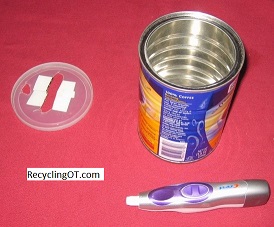
Vibrating objects usually have a motor like sound that children on the autism spectrum love! Parents, therapists and educators need to use trial and error to see which type of sensory stimulation an individual responds well to and avoid stimulation that appears to be aversive.
 This photo illustrates a simple vibrating insertion task with a removable motor attached on top. I cut a square opening into the bottle to insert blocks. This is a great way to develop skills to stabilize with the "helper" hand.
This photo illustrates a simple vibrating insertion task with a removable motor attached on top. I cut a square opening into the bottle to insert blocks. This is a great way to develop skills to stabilize with the "helper" hand.
How to motorize materials?
Vibrating devices may be activated by
- Batteries
- Plugging a cord into an electric outlet
- Using a spring loaded toy. These vibrate when pulled as the spring is released
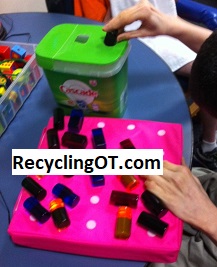
This pink vibrating cushion is plugged into an outlet. The individual is blind and enjoys removing shapes and then inserting them into the shape sorter.
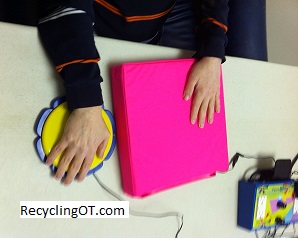
This individual enjoys pressing the switch to activate the cushion that is plugged into a control panel with a timer.

These spring loaded toys are suspended from a frame attached to a wheelchair tray.
There are obvious advantages to battery operated devices that do not require being located near an outlet. On the other hand, electronic devices do not require new or recharged batteries. Many of these devices are expensive so lets explore some relatively inexpensive options and creative ways to use them!
Inexpensive, Fun Adaptations!
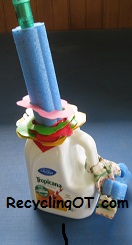
1.Make a ring stack by wedging a motor inside a swimming noodle or other tube .
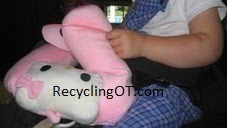
2. This soft, pink vibrating cushion is used as a ring stack. I bought it at a yard sale for $5.00 dollars!
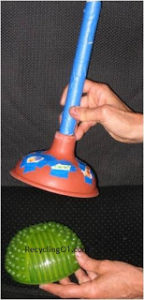
3. The brand new and very clean plunger fits over the green massager to create a ring stack.
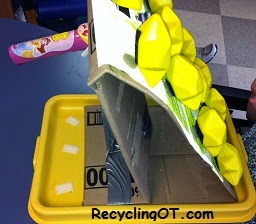
4. I attached the motor to the back of the cardboard frame so that it vibrates as the individual attaches or removes the yellow shapes from the Velcro .
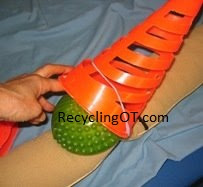
5.The green massager fits inside cones for a stacking activity.
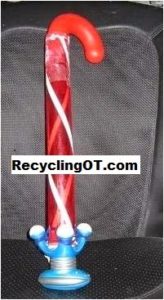
6. I attached a candy cane to a massager. I love the motor planning challenge of fitting the rings over the candy cane shape.

7. Attach a motor to the end of cord, rope or string. I like to teach stringing skills to very young children or older individuals with motor delays by using very large rings. I cut flat ring shapes out of plastic containers. they are easier to use than beads because they are larger and don't roll away. Shower curtain rings work well, too.
Let's add movement sensory stimulation!
Its easy to combine these highly motivating activities with movement. I often used them when my clients were on a horse or other type of movement apparatus such as a platform swing, scooter or trampoline. 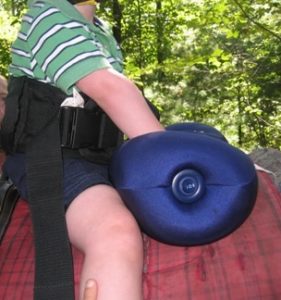
This client is strengthening his arms as he bears weight on the vibrating cushion. He is sitting on a horse that is walking at a slow, even pace. This helps clients with increased muscle tone to relax.

Weight bearing on open hands helps to decrease tactile defensiveness. My clients were so busy enjoying the vibration and movement, they forgot that they hate having anything touch their hands!
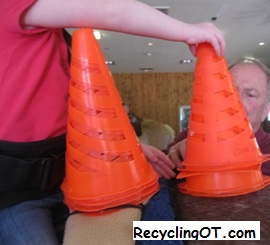
I stopped the movement while this client stacked cones. He really wants to move again and is motivated to finish the less preferred hand activity so that the horse can reward him with a trot. I call this "sensory reinforcement". It works great using a rocking chair or swing.
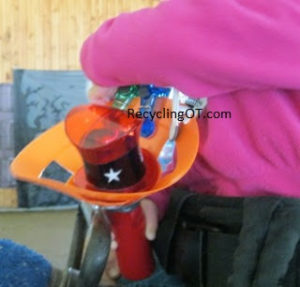
This child develops dexterity and finger strength while removing squeeze pins from a vibrating toy. 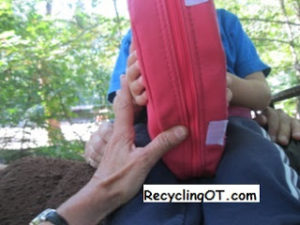
This pink cushion takes a lot of force to activate by squeezing. So, it's a great tool to strengthen arms and hands while developing balance.
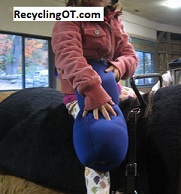 Its fun for children to touch body parts with a vibrating cushion while working on balance and motor planning skills.
Its fun for children to touch body parts with a vibrating cushion while working on balance and motor planning skills.
Combine deep pressure and vibration!
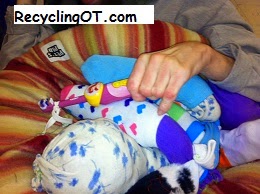
Vibrating and weighted objects may provide the alternative sensory stimulation that reduces time spent biting or sucking on hands.
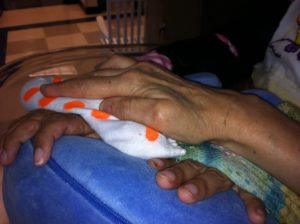
This client loves vibration and deep pressure. I briefly apply pressure repeatedly so that she is not restrained and has the option of removing her hands.
I have been adapting activities with vibration for many years... actually decades. Here are a few videos that demonstrate some success stories. Enjoy!

I am so impressed with your creativity!!!!
Thank-you! This comment is much appreciated….